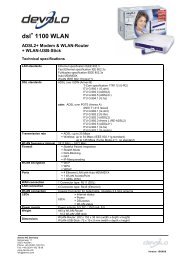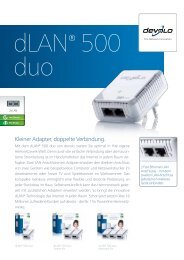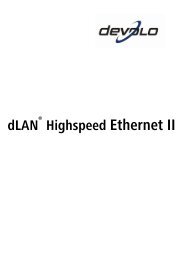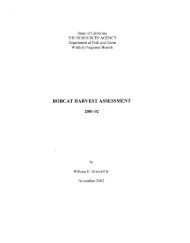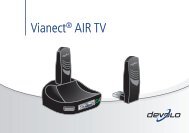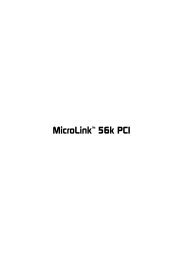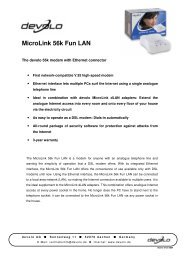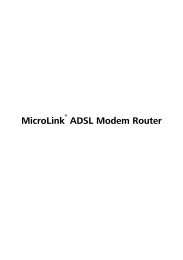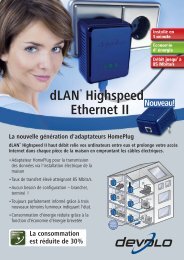dsl+ 1100 LAN.book - the world of dLAN® ... devolo AG
dsl+ 1100 LAN.book - the world of dLAN® ... devolo AG
dsl+ 1100 LAN.book - the world of dLAN® ... devolo AG
You also want an ePaper? Increase the reach of your titles
YUMPU automatically turns print PDFs into web optimized ePapers that Google loves.
6<br />
Introduction |<br />
1 Introduction<br />
1.1 What is ADSL?<br />
| <strong>devolo</strong> <strong>dsl+</strong> <strong>1100</strong> <strong>LAN</strong> |<br />
The sheer speed <strong>of</strong> development <strong>of</strong> computer technology over <strong>the</strong> last few years<br />
has resulted in a huge increase in <strong>the</strong> volume <strong>of</strong> electronic data traffic. More<br />
users want to send and receive a constantly increasing volume <strong>of</strong> data. A<br />
demand which <strong>of</strong>fers fertile grounds for <strong>the</strong> development <strong>of</strong> broadband technology.<br />
ADSL (Asymmetric Digital Subscriber Line) and <strong>the</strong> advanced ADSL2+ is a transmission<br />
technology which <strong>of</strong>fers genuine broadband communication to <strong>the</strong> user.<br />
The “last mile” connects <strong>the</strong> customer to <strong>the</strong> network via copper telephone lines.<br />
Because telephone lines are used to transmit data, <strong>the</strong> spread <strong>of</strong> this access<br />
technology has been relatively fast.<br />
Toge<strong>the</strong>r with <strong>the</strong> ADSL technology on <strong>the</strong> copper twin wire <strong>of</strong> <strong>the</strong> telephone<br />
lines, three differently large frequency ranges are used: Two for data communications<br />
and one for telephony. The term 'Asymmetric' indicates that <strong>the</strong> transmitting<br />
and receiving channels can carry different quantities <strong>of</strong> data:<br />
� When <strong>the</strong> user surfs <strong>the</strong> Internet, <strong>the</strong> data sent to <strong>the</strong> Internet service provider<br />
(ISP) tends to carry less information (e. g. addresses <strong>of</strong> web sites or emails).<br />
The transmission rate <strong>of</strong> up to 1 Mbps is generally sufficient for this<br />
purpose.<br />
� To load multimedia content (video sequences, animations, images etc.) onto<br />
<strong>the</strong> computer from <strong>the</strong> Internet at acceptable quality and speed, a transmission<br />
rate <strong>of</strong> up to 24 Mbps brings significant savings in terms <strong>of</strong> cost and<br />
time.




